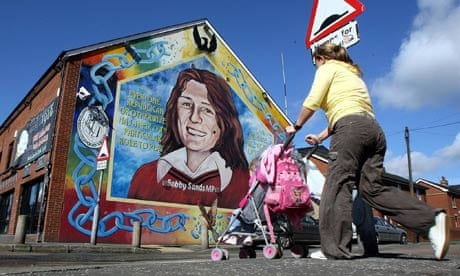Thirty years ago, eight men were on hunger strike in the Maze prison in Northern Ireland. Four of their Irish republican comrades had already fasted themselves to death, and a further six would do so in July and August.
The death of 10 men in the 1981 hunger strike was to prove a defining moment in the struggle between the Provisional IRA and the British government or, to be more precise, the prime minister, Margaret Thatcher.
The end of the strike after seven months was reported at the time as a victory for Thatcher's fortitude. In fact, it proved to be the opposite. It boosted the ranks of the IRA, radicalised nationalist politics and can now be seen as the beginning of the process that led to Sinn Féin's emergence as a vote-winning political party on either side of the disputed Irish border.
As an analyst of media coverage of the conflict from 1968 onwards, I have noted the bias that has always infected so much of the reporting about the six northern Irish counties, especially in popular papers and the rightwing serious press.
This was never illustrated more clearly than in the way the hunger strike was reported, by which I mean misreported. From start to finish, the British newspapers were guilty of misrepresentation. Editors lined up with Thatcher, supporting her policy of criminalisation in order to undermine the reality of the IRA's political motivation.
The result was distortion on a grand scale. Few papers made any attempt to explain the background to the strike – the withdrawal of political status in 1976, the subsequent blanket and dirty protests, the aborted 1980 hunger strike.
So the 1981 strike began with little coverage. Only when Bobby Sands was elected to a vacant parliamentary seat in Fermanagh and South Tyrone while on the 39th day of his hunger strike did the British press wake up. The result – astonishment and a scream of anger. Why was there such support for this man in Ireland and across the world?
But there was no genuine attempt to answer that question. Instead, the response was pitiless. "I will shed no tears when Sands dies," wrote John Junor, then editor of the Sunday Express. "My only hope is that if and when he does every other IRA terrorist will go on the same sort of hunger strike in sympathy. And stay on it until they are all in wooden suits."
Junor was not pushing a maverick line. When Sands finally succumbed on the 66th day of his fast, the press greeted his death and derided his heroism. He was guilty of "a moral fraud", said the Daily Mail. He had courage but of a "ruthless and corrupted sort", said the Daily Telegraph. "Blackmail has failed," trumpeted the Sun. "The society which has stood firm against violence in long blood-stained years will remain unshaken."
Failure was a common theme. The Daily Mirror confidently told its readers that Sands's death "advances no cause". The Express agreed: "Sands will find no victory in the grave … the shadow of Bobby Sands will pass."
Sands's funeral was marked by an outpouring of grief across Ireland, and elsewhere in the world. In Britain, and in Fleet Street's graveyard of truth, it was marked by an outpouring of vitriol.
A Mirror writer saw it as "a pathetic end for a man who never played more than an average part in the deadly moves called by his IRA masters." The funeral was nothing more than "macabre propaganda circus", said the Mail, calling the "ritual of so-called full military honours at the graveside … a gangster parody".
The real parody was illustrated by the Express with a picture of the cortege, in which Sands's son, eight-year-old Gerard, stood next to the pall-bearers. Under the headline "A sad pawn of war", the article began: "They told him his daddy was a hero. Then they sent him out into a scene he could never understand and made him the centrepiece of an IRA martyr's funeral." He was "cruelly manipulated", it added.
There have been many funerals for British soldiers down the years, attended by sons and daughters of Gerard's age. Most of them looked sad and bewildered at the rituals they witnessed. No paper would ever dare to call them pawns of war.
In the ensuing months of the strike, there was a continuing denial of reality in the press. The Sunday Telegraph's columnist Peregrine Worsthorne told us that "the English" had every reason to be proud of their "recent record in Northern Ireland since it sets the whole world a uniquely impressive example of altruistic service in the cause of peace".
Some journalists expressed exasperation at the worldwide condemnation of Thatcher's intransigence. Looking back over the files, there are endless predictions of the hunger strike's certain failure.
At its conclusion, in October 1981, the Daily Telegraph told us the deaths had been "senseless" while the Times called them "10 wasted lives" and the Sun said the prisoners' demands had been "absurd".
And then? And then there was silence. "I shall never give them political status," Thatcher has said. "Never." But papers averted their gaze as the government gave in to every demand: prisoners wore their own clothes within two weeks, prison work was eventually dropped, the men were allowed to associate freely, and they were given educational facilities.
As I pointed out earlier, the strike was hugely influential outside the Maze. Again, the British people did not realise that, because their newspapers did not tell them. And many still do not grasp that fact today.
The Telegraph, in summing up the result of the strike, proclaimed: "Hunger striking is a fairly familiar device which normally fails even to procure lasting fame for those who employ it."
Really? Whose iconic picture does one see on walls across Northern Ireland, whose name is synonymous with Irish republicanism and whose face is instantly recognisable to people born long after his death? Bobby Sands, of course.
A special conference to commemorate the hunger strike is being held at the London Irish Centre tomorrow. Details here on Facebook.

